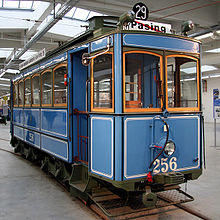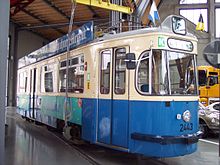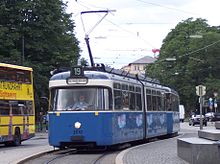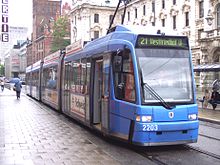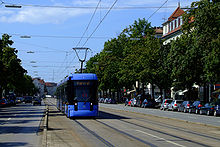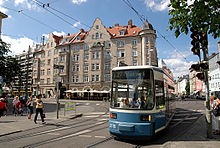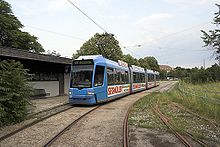- Munich Tramway
-
Munich tramway 
Info Locale Munich, Germany Transit type Tramway Number of lines 11 Number of stations 155 Daily ridership 250,000 (2007) Operation Began operation 1876 Operator(s) Münchner Verkehrsgesellschaft Technical System length 75 km (47 mi) Track gauge 1,435 mm (4 ft 8 1⁄2 in) The Munich tramway is the tramway network for the city of Munich in Germany. Today it is operated by the municipally owned Münchner Verkehrsgesellschaft (the Munich Transport Company, or MVG) and is known officially and colloquially as the Tram. Previous operators have included Société Anonyme des Tramways de Munich, the Münchner Trambahn-Aktiengesellschaft, the Städtische Straßenbahnen and the Straßenbahn München.
The tram network interconnects with the MVG's bus network, the Munich U-Bahn and the Munich S-Bahn, all of which use a common tariff as part of the Münchner Verkehrs- und Tarifverbund (Munich Transport and Tariff Association, or MVV) transit area.
The daytime tram network comprises eleven lines and is 75 kilometres (47 mi) long with 155 stops. There is also a night tram service with four routes. The network is operated by 95 trams and transported 98 million people in 2010.[1][2][3][4]
Contents
History
The tramway started in 1876, with a horsecar service. The first tramways extended from Karlsplatz (Stachus), which remains one of central nodes of Munich's tram network. Two years later, the Société Anonyme des Tramways de Munich was founded. In 1882, the Münchner Trambahn-Aktiengesellschaft (MTAG) was founded.[4][5]
Electric trams were introduced in 1895, and in 1900, the last horsecar was taken out of service. In 1907, MTAG was taken over by the city, and changed its name to Städtische Straßenbahnen. In 1919, the municipal agency Münchner Straßenbahnen was established. After World War II ended in 1945, only twenty tram lines remained; of 444 trams, only 168 were in operational condition. In 1956, the first new tram line after the war was opened.[4]
The 1972 Munich Olympic Games presaged a major expansion of public transport in the city. In 1965, construction of the Munich U-Bahn, the city's rapid transit system, was started. It opened in 1971, the same year as the transit authority MVV was founded. In 1972 a new S-Bahn network opened that, like the U-Bahn, was carried in new tunnels under the city centre. As these networks grew, they seemed to threaten the tram network, with extensive line closures in favour of the new modes.[5]
Such closures continued into the 1990s, but in 1991 the city council passed a plan to upgrade and modernize the tramway, as the trams were seen to be a better fit to expected passenger flows on many routes. Three years later, Class R2 low-floor trams were introduced, along with a night network. These were followed, in 1999, by the larger class R3 trams. In 2001, the voltage on which the trams operate was increased from 600 to 750V. The following year the MVG was formed.[4][5]
In 2009 the brand new route 23 was opened. This route acts as a feeder route for U-Bahn lines U3 and U6, to which it connects in an elaborate terminus above Münchner Freiheit U-Bahn station. The line has no interchanges with other tram routes, but is connected to the rest of the tram network by a connecting track that carries no public service.[5]
Operation
Vehicles
The tram system utilises four classes of trams:
- The class P tram is a two-section high-floor articulated motor tram carried on two four-wheeled trucks, usually operating with a similar articulated trailer tram. The trams were built by Rathgeber between 1967 and 1969, and a two car set carries 315 passengers, with 151 seated. As of 2011, there are only six sets remaining, of which two are reserved for special services. It is expected that this class will be withdrawn from general service once delivery of the current order of class S cars is completed.[6]
- The class R2 tram is a three section 100% low floor articulated motor tram carried on six axles. The trams were built by Adtranz to their GT6N design between 1994 and 1997, and carry 157 passengers, of whom 58 are seated. As of 2011, 68 trams are in service.[7]
- The class R3 tram is a four section 100% low floor articulated motor tram carried on eight axles. The trams were built by Adtranz to their GT8N2 design between 1999 and 2001, and carry 218 passengers, of whom 67 are seated. As of 2011, 20 trams are in service.[8]
- The class S tram is a five section 100% low floor articulated motor tram carried on eight axles. The trams were built by Stadler to their Variotram design, and carry 221 passengers, of whom 75 are seated. Four trams of this design were delivered in 2009, and a further 10 are on order, with delivery expected in 2011.[9][10][11]
A number of older trams are still owned by the MVG. Some are displayed in the MVG Museum, and may occasionally be seen on special services. Other Munich trams are displayed in the Verkehrszentrum (Transport Centre) of the Deutsches Museum in Munich.
Network
The tram network comprises eleven daytime routes and four night routes. The routes total 75 kilometres (47 mi) in length, including 51 kilometres (32 mi) of segregated tram lane, with 155 stops.[4][5]
The network is standard gauge track and configured to allow a maximum body width of 2.3 metres (7 ft 7 in). It is electrified using overhead lines at 750V dc. As all Munich trams are single ended, facilities for turning trams, such as turning loops or wye tracks, are provided at all termini and strategic intermediate points.[4][5][9]
Daytime routes
The daytime route network operates between 04:45 and 01:30, and comprises the following routes:[3]
Line Route Stops Time 
Scheidplatz 
 - Hohenzollernplatz
- Hohenzollernplatz  - Leonrodplatz - Rotkreuzplatz
- Leonrodplatz - Rotkreuzplatz  - Romanplatz
- Romanplatz17 21 min 
Max-Weber-Platz 
 - Rosenheimer Platz
- Rosenheimer Platz  - Ostfriedhof - Silberhornstraße
- Ostfriedhof - Silberhornstraße  - Wettersteinplatz
- Wettersteinplatz  - Großhesseloher Brücke
- Großhesseloher Brücke16 24 min 
Romanplatz – Donnersbergerstraße – Hackerbrücke  – Hauptbahnhof
– Hauptbahnhof 



 – Sendlinger Tor
– Sendlinger Tor 



14 17 min 
Amalienburgstraße – Romanplatz – Donnersbergerstraße – Hackerbrücke  – Hauptbahnhof
– Hauptbahnhof 



 – Karlsplatz
– Karlsplatz 

 – Sendlinger Tor
– Sendlinger Tor 


 – Isartor
– Isartor  – Maxmonument - Tivolistraße – Herkomerplatz – Effnerplatz
– Maxmonument - Tivolistraße – Herkomerplatz – Effnerplatz31 41 min 
Gondrellplatz – Westendstraße 
 – Lautensackstraße – Trappentreustraße – Hauptbahnhof Süd
– Lautensackstraße – Trappentreustraße – Hauptbahnhof Süd 



 – Karlsplatz
– Karlsplatz 

 – Sendlinger Tor
– Sendlinger Tor 


 – Isartor
– Isartor  – Max-Weber-Platz
– Max-Weber-Platz 
 – Herkomerplatz – Effnerplatz
– Herkomerplatz – Effnerplatz33 45 min 
Pasing Marienplatz 



 – Fürstenrieder Straße – Lautensackstraße – Trappentreustraße - Hauptbahnhof
– Fürstenrieder Straße – Lautensackstraße – Trappentreustraße - Hauptbahnhof 



 – Karlsplatz
– Karlsplatz 

 – Theatinerstraße
– Theatinerstraße  – Maxmonument - Maximilianeum – Max-Weber-Platz
– Maxmonument - Maximilianeum – Max-Weber-Platz 
 - Ostbahnhof
- Ostbahnhof 
 – Kreillerstraße
– Kreillerstraße  – St.-Veit-Straße
– St.-Veit-Straße36 52 min 
Moosach 
 – Westfriedhof
– Westfriedhof  – Leonrodplatz – Hauptbahnhof
– Leonrodplatz – Hauptbahnhof 



 – Karlsplatz
– Karlsplatz 


16 22 min 
Westfriedhof  – Leonrodplatz – Hauptbahnhof
– Leonrodplatz – Hauptbahnhof 



 – Karlsplatz
– Karlsplatz 


13 17 min 
Münchner Freiheit 
 — Potsdamer Straße — Parzivalplatz — Am Münchner Tor — Anni-Albers-Straße — Domagkstraße — Schwabing Nord
— Potsdamer Straße — Parzivalplatz — Am Münchner Tor — Anni-Albers-Straße — Domagkstraße — Schwabing Nord7 8 min 
Max-Weber-Platz 
 – Rosenheimer Platz
– Rosenheimer Platz  – Ostfriedhof – Silberhornstraße
– Ostfriedhof – Silberhornstraße  – Wettersteinplatz
– Wettersteinplatz  – Großhesseloher Brücke - Grünwald, Derbolfinger Platz
– Großhesseloher Brücke - Grünwald, Derbolfinger Platz22 32 min 
Petuelring  – Hohenzollernplatz
– Hohenzollernplatz  – Karolinenplatz – Karlsplatz
– Karolinenplatz – Karlsplatz 

 – Sendlinger Tor
– Sendlinger Tor 


 – Fraunhoferstraße
– Fraunhoferstraße 
 – Mariahilfplatz - Ostfriedhof – Giesing Bahnhof
– Mariahilfplatz - Ostfriedhof – Giesing Bahnhof 

 – Schwanseestraße
– Schwanseestraße25 34 min Night routes
The night route network operates between 01:30 and 04:30, and comprises the following routes:[12]
Line Route 
Amalienburgstraße – Romanplatz – Donnersbergerstraße – Hackerbrücke  – Hauptbahnhof
– Hauptbahnhof 



 – Karlsplatz
– Karlsplatz 

 – Sendlinger Tor
– Sendlinger Tor 


 – Isartor
– Isartor  - Max-Weber-Platz
- Max-Weber-Platz 
 – Herkomerplatz – Effnerplatz
– Herkomerplatz – Effnerplatz
Pasing Marienplatz 



 – Fürstenrieder Straße – Lautensackstraße – Trappentreustraße - Hauptbahnhof
– Fürstenrieder Straße – Lautensackstraße – Trappentreustraße - Hauptbahnhof 



 – Karlsplatz
– Karlsplatz 

 – Theatinerstraße
– Theatinerstraße  – Maxmonument - Maximilianeum – Max-Weber-Platz
– Maxmonument - Maximilianeum – Max-Weber-Platz 
 - Ostbahnhof
- Ostbahnhof 
 – Kreillerstraße
– Kreillerstraße  – St.-Veit-Straße
– St.-Veit-Straße
Moosach 
 – Westfriedhof
– Westfriedhof  – Leonrodplatz – Hauptbahnhof
– Leonrodplatz – Hauptbahnhof 



 – Karlsplatz
– Karlsplatz 



Petuelring  - Nordbad - Kurfürstenplatz - Karolinenplatz - Karlsplatz (Stachus) - Sendlinger Tor
- Nordbad - Kurfürstenplatz - Karolinenplatz - Karlsplatz (Stachus) - Sendlinger Tor 


 - Fraunhoferstraße
- Fraunhoferstraße 
 - Mariahilfplatz - Ostfriedhof - Silberhornstraße
- Mariahilfplatz - Ostfriedhof - Silberhornstraße  - Wettersteinplatz
- Wettersteinplatz  - Südtiroler Platz - Großhesseloher Brücke
- Südtiroler Platz - Großhesseloher BrückeFuture developments
An extension from its current Effnerplatz terminus to St. Emmeram is currently under construction. The extension will be 4.3 kilometres (2.7 mi) long and will add seven new tram stops to the network. It is expected to open in December 2011.[5][13]
Four tram lines will be changed once the new extension to St. Emmeram is opened to public on 10 December 2011.
- Tram 16 line will be extended from Sendlinger Tor to St. Emmeram via Max-Weber-Platz, taking over same line as current Tram 18 from Sendlinger Tor to Effnerplatz.
- Tram 17 line will no longer serve Müllerstraße-Effnerplatz section as it will take over the southern section of Tram 27 line from Müllerstraße to Schwanseestraße.
- The eastern section of Tram 18 line will be adjusted so that it would take over the current Tram 17 line between Isartor and Effnerplatz via Maxmonument (Lehel).
- Tram 27 line will be abbreviated to terminate at Sendlinger Tor.
On the western side of the city, Tram 19 line is being extended from its current terminus at Pasing-Marienplatz to the München-Pasing train station for the better interchange with S-Bahn and long-distance train services. The extension at the München-Pasing train station will be in form of an elongated one-way loop and is expected to open in late 2013.
The new 8.7 kilometres (5.4 mi) Tram Westtangente line is being constructed between Romanplatz and Aidenbachstraße U-Bahn station.[5][14][15] The line will stop at three U-Bahn and S-Bahn transfer points: Holzapfelkreuth U-Bahn station, Laimer Platz U-Bahn station, and München-Laim S-Bahn station. The tram line designation number has not been selected yet. It is expected to be completed in 2014.
Munich has expressed the interest in building the northern line between Elizabethplatz and Tivolistraße as to relieve the tramway congestion in the city centre and as to reduce the vehicular noise caused by the buses. Due to the line's travelling through the environmentially sensitive Englischer Garten, the overhead lines and poles aren't permitted to be fitted. Thus, it has been proposed that the trams fitted with batteries be utilised for the Englischer Garten section before reverting back to overhead lines as to continue the journey while recharging the batteries. MVG and Stadler have equipped one of the S class trams with experimental lithium-ion batteries for the trial run. In May 2011, the experimential tram had set the world distance record for operating on batteries alone: 16 kilometres (9.9 mi) on a test track at Velten near Berlin. The remaining S class trams, both delivered and on order, are designed to be retro-fitted with a similar installation.[11][16]
References
- ^ "Press Release 10.12.2009_t23_3_mvg-pressemeldung". MVG. http://www.mvg-mobil.de/presse/presse_2009/pdf/10.12.2009_t23_3_mvg-pressemeldung.pdf. Retrieved 12 December 2009.[dead link]
- ^ "MVG: wieder Fahrgastrekord bei U-Bahn, Bus und Tram; Zuwachs in allen Betriebszweigen [MVG: Passenger record at U-Bahn, bus and tram; growth in all operating sectors]" (in German). MVG. 27 May 2011. http://www.mvg-mobil.de/presse/2011-05-27_mvg-pressemeldung.pdf. Retrieved 7 June 2011.
- ^ a b "Tramnetz München [Munich Tram Network]" (in German). MVV. http://www.mvv-muenchen.de/web4archiv/objects/download/3/barrierefrei_tram_2010.pdf. Retrieved 7 June 2011.
- ^ a b c d e f Münchner Verkehrsgesellschaft (5 April 2010). "The MVG Network in Figures" (pdf). http://www.mvg-mobil.de/ueberuns/images/mvg_in_figures_s.pdf. Retrieved 3 March 2011.
- ^ a b c d e f g h Pulling, Neil (November 2010). "System Factfile 38: Munich, Germany". Tramways & Urban Transit (Ian Allan Ltd / Light Rail Transit Association): pp. 419–421.
- ^ "Tram Typ P [Tram Type P]" (in German). MVG. http://www.mvg-mobil.de/ueberuns/fahrzeuge/tram-p.html. Retrieved 9 June 2011.
- ^ "Tram Typ R 2 [Tram Type R 2]" (in German). MVG. http://www.mvg-mobil.de/ueberuns/fahrzeuge/tram-r2.html. Retrieved 9 June 2011.
- ^ "Tram Typ R 3 [Tram Type R 3]" (in German). MVG. http://www.mvg-mobil.de/ueberuns/fahrzeuge/tram-r3.html. Retrieved 9 June 2011.
- ^ a b Stadler Rail. "Niederflurstraßenbahn Typ Variobahn für die Stadtwerke München GmbH (SWM)" (in German). http://www.stadlerrail.com/images/content/datenblaetter/05_variobahn/SWM_D.pdf. Retrieved 3 April 2009.[dead link]
- ^ "Tram Typ S [Tram Type S]" (in German). MVG. http://www.mvg-mobil.de/ueberuns/fahrzeuge/tram-s.html. Retrieved 9 June 2011.
- ^ a b "Stadler sets new catenary-free world record". Tramways & Urban Transit (Ian Allan Ltd / Light Rail Transit Association): pp. 251. July 2011.
- ^ Nachtlinien (PDF)
- ^ "Tram St. Emmeram" (in German). MVG. http://www.mvg-mobil.de/projekte/st_emmeram/index.html. Retrieved 17 June 2011.
- ^ "Tram Pasing" (in German). MVG. http://www.mvg-mobil.de/projekte/pasing/index.html. Retrieved 17 June 2011.
- ^ "Tram Westtangente" (in German). MVG. http://www.mvg-mobil.de/projekte/westtangente/index.html. Retrieved 17 June 2011.
- ^ "Straßenbahn oben ohne – Münchner Tram mit Batterieantrieb schafft Weltrekord [Munich Tram with Battery drive creates world record]" (in German). MVG. http://www.mvg-mobil.de/presse/2011-05-26c_mvg-pressemeldung.pdf. Retrieved 30 June 2011.
External links
Categories:- Tram transport in Germany
- Rail transport in Munich
Wikimedia Foundation. 2010.

